Challenging the forces of nature
Young scientists competed in several science challenges to understand and tame the forces of nature.
By Emily Sohn
A tsunami is approaching the beach. Time is running out. In just 20 minutes, it’ll be all over.
“We should start focusing on how to prevent the tsunami,” says 14-year-old Anudeep Gosal of Orlando, Fla. His teammates, all 12-to-14-year-olds, are drawing on a dry-erase board and experimenting with ways to block the giant wave. The clock keeps ticking.
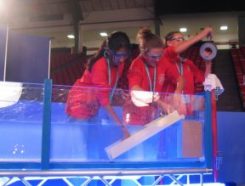 |
|
Caption: Members of the red team construct a “beach” in a water tank as part of a tsunami simulation.
|
| Emily Sohn |
“There’s 7 minutes and 49 seconds to finish this thing,” Anudeep says. He shakes his head, grabs a handful of plastic zip ties, and runs to the water’s edge.
Can a teenager in jeans and a gray T-shirt stop the destructive power of a massive wave with just a bundle of plastic strips and the help of his friends? The answer is: No.
Luckily, this nightmare is just a simulation. Figuring out how to tame a tsunami’s destructive power was one of six 90-minute problems presented to finalists at this year’s Discovery Channel Young Scientist Challenge (DCYSC).
Every year, DCYSC brings the nation’s top 40 middle-school science-fair winners to Washington, D.C., to compete for thousands of dollars in scholarship money, dream science trips, and other prizes. Students work in teams of five, but judges score them individually on their ability to cooperate, communicate, and think through problems. As deadlines loom, Discovery Channel interviewers and cameramen push their way into the action.
Tsunami science
In “Tsunami Science,” the grey team’s first challenge, finalists faced a 40-foot-long tank that was 5 inches wide and filled about halfway along its length with 10 inches of water. A nearby table held strips of sheet metal, plastic boxes, wooden boards, and various tools.
First, finalists had to figure out how to create waves at one end of the tank. The grey team did it by sliding a big box into the water. Other teams used a paddle. Teams also had to make sure each wave they made was the same so that they could measure how high the water splashed at the other end. Splash height represented the wave’s power to destroy.
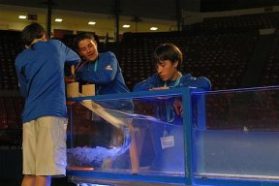 |
|
Blue team members use a board to create a wave powerful enough to reach the opposite end of the water tank.
|
| DCYSC |
“If we were small people in that tank, we’d feel so helpless,” said red team member Taylor Jones, who’s from Maryville, Tenn.
With these imaginary little people in mind, teams then had to work out how to tame the tsunami by building fake beaches or other types of terrain that would absorb its impact. Before their 90 minutes were up, teams needed to film a 3-minute newscast to explain their findings.
Creating the video was just as important as solving the problem, says head judge Steve “Judge Jake” Jacobs.
“We don’t have enough science communicators,” he says. “That’s why people are scared of all this stuff.”
Eye of the storm
Averting disaster and alleviating fear came up a lot at DCYSC this year. Its official theme was “Forces of Nature,” and most challenges involved dangerous situations that occur in the natural world.
In “Eye of the Storm,” for instance, teams had to create a tornado by positioning fans around a platform. Smoke came out of a hole in the floor, while a 600-pound fan sucked air upwards from a height of 30 feet. If finalists set the direction and power of the fans just right, they could create a tall, spiraling funnel cloud.
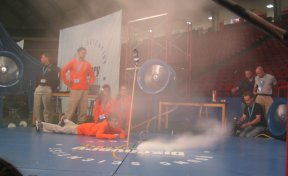 |
|
Members of the orange team have to adjust fans to turn a stream of smoke into a tornado-like funnel cloud.
|
| Emily Sohn |
Over at “Into the Thick of It,” meanwhile, finalists experienced what airplane pilots see when they have to land in thick fog. In a 16,000-square-foot test chamber filled with mist, teams compared differently colored boards to see which ones were most visible. (Yellow and white, it turns out, worked best).
Standing up to the forces of nature showed students that understanding the science behind tsunamis, hurricanes, tornadoes, and thick fog can help us protect ourselves, even if we can’t prevent them from forming in the first place.
Emergency workers
Recent disasters have also shown that just being prepared for a disaster isn’t enough. Injuries and deaths still happen.
And so, “In Case of Emergency” challenged finalists to act as emergency workers and clean up a pile of toxic medical waste, including bloody gauze pads, gooey pus, and amputated body parts. The objects were fake, but they looked nauseatingly real and smelled gross.
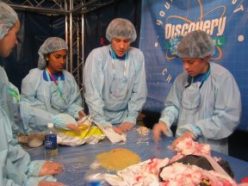 |
|
In one challenge, DCYSC finalists had to clean up a pile of toxic medical waste.
|
| Emily Sohn |
“Where are we going to put the bloody hand?” asked blue team member Aaron Rozon of Hawaii, as he poured a package of potato chips over it. He wanted to use the plastic bag as a wrapper for waste. Wiping his hands on his apron, he added, “I’m totally covered in this stuff.”
When the judges used a black (ultraviolet) light to reveal how completely contaminated everyone was, 14-year-old Neela Thangada of Texas looked disappointed. “We should’ve had a plan,” she said. “With division of labor, we would’ve done a much better job.”
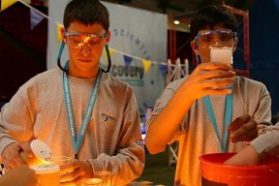 |
|
Elijah Mena and Anudeep Gosal use ordinary table salt while trying to separate unknown substances in a mixture.
|
| DCYSC |
Teams discovered that planning ahead was important for all the challenges. Simply jumping into problems and trying to solve them through trial and error could quickly lead them off track. Making and testing hypotheses worked much better.
Talking and thinking
Communication also emerged as a major asset. The yellow team, for example, found out during the tornado challenge that their quietest member, Garrett Yazzie, also had some of the best ideas.
“I don’t talk a lot,” says Garrett, who’s from Pinon, Ariz. “I’m more of a thinker.”
Once his team recognized the nature of their group dynamics, they were more willing to listen when Garrett spoke. “Soft voice, loud voice,” said Shireen Dhir of Georgia, “as long as you get your idea across, that’s what matters.”
As finalists gained confidence in their ability to think like scientists and communicate ideas, their fear of natural disasters seemed to slip away.
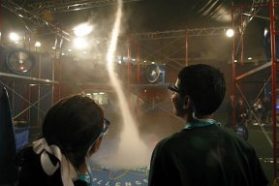 |
|
Camden Miller and Nilesh Raval of the green team watch their team’s tornado.
|
| DCYSC |
At home in Florida, Heather Foster, 15, has seen a number of frightening hurricane-caused tornadoes. Watching the tornado that she helped create, however, made her giddy.
“This is fun,” Heather said. She hopped and clapped every time a funnel formed. “Next time it might make me want to run up to a tornado and see it, because this is really cool.”
For the record, if a real tornado comes your way, head for the basement. Unless you’re on the set of a Discovery Channel event, the eye of a storm is not a safe place to be.
Going Deeper:







